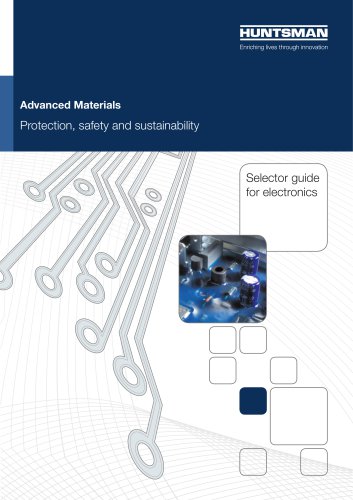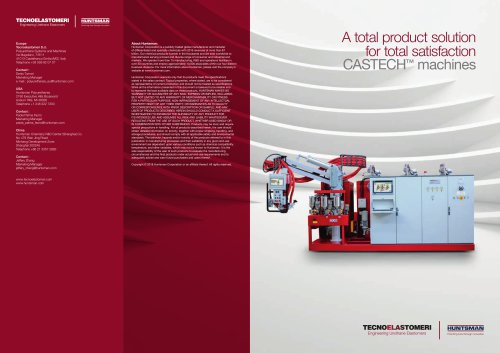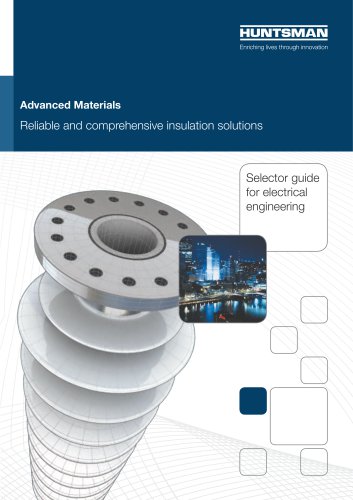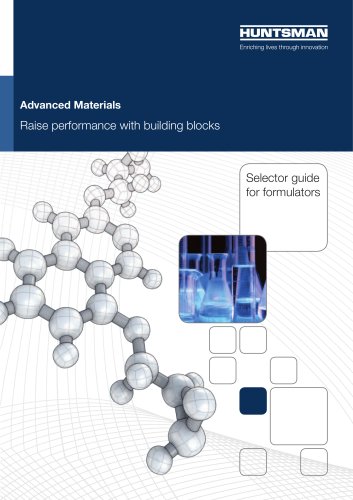
カタログの抜粋

A guide to thermoplastic polyurethanes (TPU)
カタログの1ページ目を開く
Table of contents page Physical properties Chemical properties Chemical resistance Specific quality classifications What is thermoplastic polyurethane (TPU)?
カタログの2ページ目を開く
A guide to TPU Thermoplastic polyurethanes (TPUs) offer exciting possibilities for meeting the manufacturing challenges of a fast-changing world. Well-known for their outstanding versatility, Huntsman's TPUs can improve the production and enrich the performance of anything from shoes, seals and films to filters, conveyor belts and cables. Building on years of experience, we have developed a large number of TPUs with limitless potential to meet adhesive, coating, injection molding, extrusion, film and compounding application requirements. • Innovative solutions that can be customized to...
カタログの3ページ目を開く
1. What is TPU? Thermoplastic polyurethane (TPU) is a unique category of plastic created when a polyaddition reaction occurs between a diisocyanate and one or more diols. First developed in 1937, this versatile polymer is soft and processable when heated, hard when cooled and capable of being reprocessed multiple times without losing structural integrity. Used either as a malleable engineering plastic or as a replacement for hard rubber, TPU is renowned for many things including its: high elongation and tensile strength; its elasticity; and to varying degrees, its ability to resist oil,...
カタログの4ページ目を開く
Thermoplastic Polyurethanes
カタログの5ページ目を開く
2. TPU chemistry A TPU is a multi-phase block copolymer that is created when three basic raw materials are combined together in a specific way. The individual components required to produce a TPU are: • A polyol or long-chain diol • A chain extender or short-chain diol • A diisocyanate Figure 1.0 depicts the basic chemistry of TPU. The soft block, built out of a polyol and an isocyanate, is responsible for the flexibility and elastomeric character of a TPU. The hard block, constructed from a chain extender and isocyanate, gives a TPU its toughness and physical performance properties. Figure...
カタログの6ページ目を開く
3. TPU from Huntsman IROGRAN®, AVALON®, KRYSTALGRAN® and IROSTIC® are the four main TPU brands produced by the polyurethanes division of Huntsman. Available in an array of different grades, each has its individual characteristics and can be tailored for either basic plastic product applications or more complex engineering projects. Regardless of brand, all TPU grades have some common performance traits that set them apart from other plastic materials. These typically include: • High abrasion resistance • High elasticity across the entire hardness range • Excellent low-temperature and impact...
カタログの8ページ目を開く
About Huntsman Huntsman is a global manufacturer and marketer of differentiated chemicals. Its operating companies manufacture products for a variety of global industries, including chemicals, plastics, automotive, aviation, textiles, footwear, paints and coatings, construction, technology, agriculture, health care, detergent, personal care, furniture, appliances and packaging. Originally known for pioneering innovations in packaging and, later, for rapid and integrated growth in petrochemicals, Huntsman today has more than 11,000 employees and operates from multiple locations worldwide....
カタログの9ページ目を開く
4. Physical Properties Material Resistance The mechanical properties of a TPU can be evaluated in a number of different ways. Detailed below are some of the standard assessments used to measure a TPU’s characteristics and define what can be expected in terms of physical performance and longevity. Shore hardness Shore hardness is an empirical measurement used to test a TPU’s resistance to indentation or penetration under a defined force. Two letters are used to categorize the type of TPU being appraised: ‘A’ denotes a flexible type of TPU while ‘D’ refers to more rigid varieties. These two...
カタログの10ページ目を開く
Physical properties
カタログの11ページ目を開く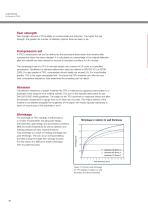
Tear strength Tear strength denotes a TPU’s ability to counter break and distortion. The higher the tear strength, the greater the number of utilization options there are likely to be. A TPU’s compression set can be defined as the permanent deformation that remains after compressive stress has been released. It is calculated as a percentage of the original deflection after the material has been allowed to recover at standard conditions for 30 minutes. The compression set of a TPU is normally tested over a period of 24 hours at a specified temperature. Guidelines for standard deformation...
カタログの12ページ目を開く
Physical properties
カタログの13ページ目を開く
5. Chemical properties A TPU’s chemistry will dictate its behavior in certain environments. It is therefore, important to choose the proper grade particularly if exposure to high temperatures, water and / or outdoor elements is a consideration. The degree to which any changes occur is dependent on the nature of the solution, compound or element involved; its concentration; the formulation of the TPU; and processing and application temperatures. Acids and alkaline solutions TPU has limited resistance to acids and alkaline solutions. It can only withstand diluted acids and alkaline solutions...
カタログの14ページ目を開く
Chemical properties
カタログの15ページ目を開く
IROGRAN® resistance properties Medium Acetone AL-chloride, aqueous, 5 % Ammonia, 10 % Aniline ASTM Fuel A ASTM Fuel B ASTM Fuel C ASTM oil 1 ASTM oil 2 ASTM oil 3 Ethanol 96 % Petrol, standard grade Petrol, premium grade Benzene Butanol Butylacetate Cyclohexanol Dibutylphthalate Diesel oil Dimethylformamide Acetic acid 3 n Acetic acid, 20 % Ethylacetate Ethylether Fe chloride, aqueous, 5 % Glycol Glysantin / water 1:1 Glysantin / water 1:1 Isopropanol Kerosine Sodium chloride solution, conc. Methanol Methylen chloride Methylethylketone Mineral oil Soda soap fat Sodium hydroxide solution 1N...
カタログの16ページ目を開く
IROGRAN® resistance properties
カタログの17ページ目を開く
6. Chemical resistance Solvents Depending on the type of alcohol-based solvent used, the effect on a TPU may differ. Aliphatic alcohols such as ethanol and isopropanol can trigger slight swelling. More obvious levels of distortion can occur with exposure to aliphatic esters and ketones including acetone, methyl ethyl ketone (MEK) and cyclohexanone. Strong polar organic solvents like dimethyl formamide (DMF) and dimethyl sulfoxide (DMSO) can dissolve TPU altogether. Microbial resistance In applications where a TPU is in regular contact with soil in either hot or humid environments, its...
カタログの18ページ目を開くHuntsman Advanced Materialsのすべてのカタログと技術パンフレット
-
Electrical Engineering
20 ページ
-
Panel laminating
5 ページ
-
Resins selector guide
12 ページ
-
Advanced Materials
28 ページ
-
Tooling Boards
2 ページ
-
Tooling Selector Guide
16 ページ
-
Wind Selector Guide
12 ページ
-
Aerospace Selector Guide
16 ページ




